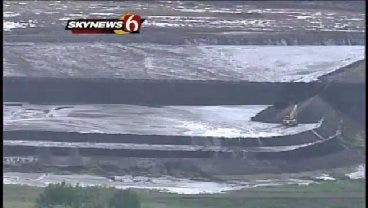Oklahoma Fails Small Town In Fly Ash Regulation
A group of small-town Oklahomans have inserted themselves into the middle of the battle between the EPA and the U.S. coal industry because they say an industrial byproduct, fly ash, is killing them, literally.Thursday, October 28th 2010, 10:23 pm
Jennifer Loren, The Oklahoma Impact Team
BOKOSHE, Oklahoma -- Right now, the Environmental Protection Agency (EPA) is trying to decide if it should regulate an industrial byproduct called Fly Ash. It's a battle that pits environmentalists against the $66 billion US coal industry. A group of small-town Oklahomans have inserted themselves into the middle of the battle because they say fly ash is killing them, literally.
It starts with coal.
Trains ship billions of tons of coal into Oklahoma every year to be burned at coal-fired electric power plants. The byproduct of burned coal is a powdery substance called Coal Combustion Waste, more commonly called fly ash. Sometimes fly ash is dumped on-site at the power plants. Other times it's sold to industrial recycling companies to be used in construction products like cement mix. But many times fly ash is taken by the truckload to off-site dumps.
There are at least 12 fly ash sites scattered across Oklahoma, but none bigger than the one in Bokoshe. It's an old mine that's being "reclaimed" with the fly ash, but it's 55 feet tall and covers more than 20 acres. It's about a mile from the center of Bokoshe.
The lone cafe in town, Sassy's, has become headquarters for the people of Bokoshe, fighting in the battle of their lives. It's a battle against big coal, power companies and it turns out, the very state agencies put in place to protect them.
"They thought that they could come into a town of about 450 people and they could do pretty much what they wanted to do and that we would sit back and allow them to do so, but they underestimated their opponent," said Sharon Tanksley, Bokoshe Resident.
It took seven years living in a haze of fly ash, but small town Oklahoma won their first battle against the state last year. They proved to the Oklahoma Department of Environmental Quality that the ash was being dumped illegally and blanketing their town in harmful chemicals. DEQ now requires that water is mixed with the ash to keep it from contaminating the air.
Health Problems
Lifelong resident, Charles Tackett, said he believes their victory came too late.
"We have had a very bad rash of cancers and respiratory problems," Tackett said.
Tackett said people in 14 of the 20 families living closest to the dump have died from or are living with cancer.
In the local sixth grade classroom, fly ash is often a topic of discussion. The children have learned the environmental effects of the dust they breathed for so many years. They said they're living with the health effects.
"Would you raise your hands please if you have respiratory problems?" asked the teacher. Half the class raised their hands. Nine out of the 17 sixth graders have asthma. That's six times the national average.
Bokoshe residents cannot prove their health problems are caused by the fly ash, but fly ash contains dozens of chemicals proven to be harmful. EPA documents show the local power plant dumped fly ash containing more than 56,000 pounds of arsenic compounds, 1,100 hundred pounds of mercury and 1,000 pounds of lead at the site in 2007 alone.
Water monitoring revealed waste water toxins running off the fly ash site in Bokoshe, but state agencies did nothing until the EPA stepped in and issued a cease and desist order. That order didn't stop the fly ash from being dumped there. It only stopped the dumping of a certain type of waste water there. That is only temporary.
EPA's Proposal
Right now the EPA is considering labeling fly ash a hazardous waste. If they do so, the feds would take over regulation from states. In Dallas, the EPA held a public hearing on that very topic. At a microphone in front of an EPA panel, people took a couple of minutes to give their opinions on the record.
A large group of environmentalists with the Sierra Club held a protest at the same time.
"Move beyond coal! Move beyond coal!" they chanted, holding signs that painted with phrases like, "Coal ash is toxic!"
The Executive Director of the Sierra Club, Michael Brune, said even though the people of Bokoshe can't prove their health problems are a direct result of fly ash contamination, it's obvious.
"We know that communities around coal ash sites, where the water has been contaminated, that people are getting sick. So if you add two plus two you come to four and you realize that when toxic substances get into the air we breathe or the water that we drink bad things happen as a result," Brune said. "It's a toxic substance. It's poisonous. It makes people sick, and we need to treat it as such."
But many of the people at the Dallas hearing were lobbyists against many of the rules the EPA is proposing for fly ash.
"Fly ash does not rise to the level of toxicity that would qualify it as a hazardous waste based on what's in it," said John Ward with the group, Citizens for Recycling First.
Ward's group thinks labeling fly ash a hazardous waste will only make the problem worse. He said the best way to deal with fly ash disposal issues is to stop throwing it away and recycle it. Ward said the "hazardous waste" designation will put a stop to all of the current fly ash recycling efforts because no one will want products with a hazardous waste product in them. He argued that fly ash is safe when it's recycled. If it is not recycled, he said, there will be more fly ash going to dumps.
"It makes the concrete stronger, it makes it last longer, and most of all it keeps the material out of the landfills and reduces green house gas emissions," Ward said.
A lobbyist for Oklahoma's American Electric Power (AEP) spoke to the EPA panel, "This would dramatically increase disposal costs and our customer's electricity rates without environmental benefit."
Several Bokoshe residents made the trip to Dallas to give the EPA their comments. They shook their heads as lobbyists said fly ash isn't hazardous, and when it was their turn, asked the EPA to step in because Oklahoma's regulating agencies have let them down.
"My message to you today is that the state regulatory agencies in Oklahoma have failed," said Bokoshe resident Susan Holmes.
But the Oklahoma Department of Environmental Quality feels otherwise. The Director of DEQ's Land Protection Division, Scott Thompson, said they are doing a good job regulating fly ash. They are in charge of regulating about half of the state's fly ash sites.
Other sites
One site they regulate is at the AEP/PSO power plant in Oologah. Documents showed fly ash has been dumped there since 1978, but the DEQ only began testing the groundwater there two years ago. Recent DEQ water samples show the fly ash has contaminated the groundwater underneath their site. But Thompson said the EPA doesn't believe that water has made it into the nearby Verdigris River. Thompson said they will require AEP/PSO to put up a slurry wall at the river to keep water from seeping out. The EPA may also require AEP/PSO to put in a new liner beneath their pit. Those are long-term projects with no estimated time frame for completion.
Fly ash is being used at another site in Fort Gibson, as part of a mine reclamation project. Neighbors complained about the water running off-site. We discovered the DEQ has monitored that site in the past, but is not currently testing any water there. That water feeds directly into the Grand River, Fort Gibson's drinking water supply.
"You know you think somebody in the government is there protecting us. We've got these agencies and they're supposed to be helping us so I feel safe. And then you find out things along the way and you say no, huh-uh," said concerned Fort Gibson resident Jean McMahon.
The Oklahoma Impact Team decided to test the water and found a stream running directly from the old mine into a culvert on the side of the road. We collected a sample and sent it to a local lab. The results showed the presence of several heavy metals including selenium, which in high doses can cause circulatory problems. The selenium in the sample was three times the allowable level for drinking water.
But DEQ officials said no Oklahoma public water supply is at risk. It's tested and treated before anyone drinks it. Thompson said people need to know the metals found in fly ash are naturally occurring metals and would be found in water samples anyway. He believes some of the EPA's standards are too stringent. He does not want the EPA to regulate fly ash.
Who's in charge?
When it comes to Bokoshe, Thompson said, the DEQ is not in charge of the water there. He said that's the Corporation Commission's responsibility. DEQ only regulates the air at that site. And the fly ash? The Oklahoma Department of Mines is in charge of that.
"Don't you feel like you should be regulating all of these sites?" asked Oklahoma Impact Team's Jennifer Loren.
"That's not up to me. That's up to the legislature and the governor's office and all that," Thompson said.
"Do you think that that's a problem?" Loren asked.
"I don't know. There could be some problems," Thompson said.
In Bokoshe they said those problems are killing them.
"I don't feel like that they ought to be able to destroy my health, make my property not worth anything, and the environment. I think the environment is more important right now than anything," said Charles Tackett, Bokoshe resident.
At one point Bokoshe residents tried to enlist the help of Congressman Dan Boren and Senator Jim Inhofe. Both signed a letter supporting the site, stating that the mountain of fly ash there was only temporary and will soon disappear.
More Like This
October 28th, 2010
January 2nd, 2025
Top Headlines
June 10th, 2025
June 10th, 2025
June 10th, 2025
















